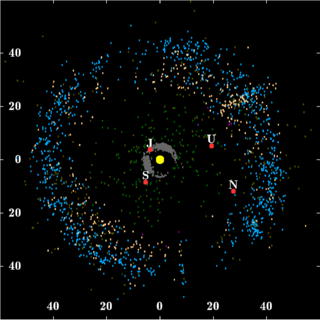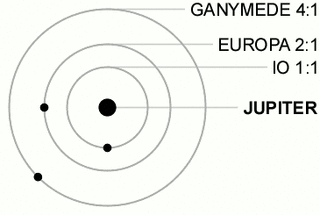Related Research Articles

The Kuiper belt is a circumstellar disc in the outer Solar System, extending from the orbit of Neptune at 30 astronomical units (AU) to approximately 50 AU from the Sun. It is similar to the asteroid belt, but is far larger—20 times as wide and 20–200 times as massive. Like the asteroid belt, it consists mainly of small bodies or remnants from when the Solar System formed. While many asteroids are composed primarily of rock and metal, most Kuiper belt objects are composed largely of frozen volatiles, such as methane, ammonia, and water. The Kuiper belt is home to most of the objects that astronomers generally accept as dwarf planets: Orcus, Pluto, Haumea, Quaoar, and Makemake. Some of the Solar System's moons, such as Neptune's Triton and Saturn's Phoebe, may have originated in the region.

Miranda, also designated Uranus V, is the smallest and innermost of Uranus's five round satellites. It was discovered by Gerard Kuiper on 16 February 1948 at McDonald Observatory in Texas, and named after Miranda from William Shakespeare's play The Tempest. Like the other large moons of Uranus, Miranda orbits close to its planet's equatorial plane. Because Uranus orbits the Sun on its side, Miranda's orbit is perpendicular to the ecliptic and shares Uranus' extreme seasonal cycle.

In celestial mechanics, orbital resonance occurs when orbiting bodies exert regular, periodic gravitational influence on each other, usually because their orbital periods are related by a ratio of small integers. Most commonly, this relationship is found between a pair of objects. The physical principle behind orbital resonance is similar in concept to pushing a child on a swing, whereby the orbit and the swing both have a natural frequency, and the body doing the "pushing" will act in periodic repetition to have a cumulative effect on the motion. Orbital resonances greatly enhance the mutual gravitational influence of the bodies. In most cases, this results in an unstable interaction, in which the bodies exchange momentum and shift orbits until the resonance no longer exists. Under some circumstances, a resonant system can be self-correcting and thus stable. Examples are the 1:2:4 resonance of Jupiter's moons Ganymede, Europa and Io, and the 2:3 resonance between Neptune and Pluto. Unstable resonances with Saturn's inner moons give rise to gaps in the rings of Saturn. The special case of 1:1 resonance between bodies with similar orbital radii causes large planetary system bodies to eject most other bodies sharing their orbits; this is part of the much more extensive process of clearing the neighbourhood, an effect that is used in the current definition of a planet.

Tidal locking between a pair of co-orbiting astronomical bodies occurs when one of the objects reaches a state where there is no longer any net change in its rotation rate over the course of a complete orbit. In the case where a tidally locked body possesses synchronous rotation, the object takes just as long to rotate around its own axis as it does to revolve around its partner. For example, the same side of the Moon always faces the Earth, although there is some variability because the Moon's orbit is not perfectly circular. Usually, only the satellite is tidally locked to the larger body. However, if both the difference in mass between the two bodies and the distance between them are relatively small, each may be tidally locked to the other; this is the case for Pluto and Charon, as well as for Eris and Dysnomia. Alternative names for the tidal locking process are gravitational locking, captured rotation, and spin–orbit locking.

(612243) 2001 QR322, prov. designation: 2001 QR322, is a minor planet and the first Neptune trojan discovered, by American astronomer Marc Buie of the Deep Ecliptic Survey at Cerro Tololo Observatory in Chile on 21 August 2001. It orbits ahead of Neptune at its L4 Lagrangian point and measures approximately 132 kilometers (82 miles) in diameter.

Planetary migration occurs when a planet or other body in orbit around a star interacts with a disk of gas or planetesimals, resulting in the alteration of its orbital parameters, especially its semi-major axis. Planetary migration is the most likely explanation for hot Jupiters. The generally accepted theory of planet formation from a protoplanetary disk predicts that such planets cannot form so close to their stars, as there is insufficient mass at such small radii and the temperature is too high to allow the formation of rocky or icy planetesimals.
Planet V is a hypothetical fifth terrestrial planet posited by NASA scientists John Chambers and Jack J. Lissauer to have once existed between Mars and the asteroid belt. In their hypothesis the Late Heavy Bombardment of the Hadean era began after perturbations from the other terrestrial planets caused Planet V's orbit to cross into the asteroid belt. Chambers and Lissauer presented the results of initial tests of this hypothesis during the 33rd Lunar and Planetary Science Conference, held from March 11 through 15, 2002.

The dwarf planet Pluto has five natural satellites. In order of distance from Pluto, they are Charon, Styx, Nix, Kerberos, and Hydra. Charon, the largest, is mutually tidally locked with Pluto, and is massive enough that Pluto–Charon is sometimes considered a double dwarf planet.

Gliese 876 c is an exoplanet orbiting the red dwarf Gliese 876, taking about 30 days to complete an orbit. The planet was discovered in April 2001 and is the second planet in order of increasing distance from its star.
"Clearing the neighbourhood" around a celestial body's orbit describes the body becoming gravitationally dominant such that there are no other bodies of comparable size other than its natural satellites or those otherwise under its gravitational influence.
The Hungaria asteroids, also known as the Hungaria group, are a dynamical group of asteroids in the asteroid belt which orbit the Sun with a semi-major axis between 1.78 and 2.00 astronomical units (AU). They are the innermost dense concentration of asteroids in the Solar System—the near-Earth asteroids are much more sparse—and derive their name from their largest member 434 Hungaria. The Hungaria group includes the Hungaria family, a collisional asteroid family which dominates its population.
A Hecuba-gap asteroid is a member of a dynamical group of resonant asteroids located in the Hecuba gap at 3.27 AU – one of the largest Kirkwood gaps in the asteroid belt, which is considered the borderline separating the outer main belt asteroids from the Cybeles. A Hecuba-gap asteroid stays in a 2:1 mean motion resonance with the gas giant Jupiter, which may gradually perturbe its orbits over a long period until it either intersect with the orbit of Mars or Jupiter itself. Depending on the dynamical stability of an asteroid's orbit in the Hecuba gap, three subgroups have been proposed. These are the marginally unstable Griqua asteroids, with an estimated lifetime of more than 100 million years, the stable Zhongguo asteroids, and an unnamed, strongly unstable population of asteroids with a dynamical lifetime of less than 70 million years.
HD 5319 is an 8th magnitude star approximately 319 light years away in the constellation Cetus. It is a subgiant star of spectral type K3, having run out of hydrogen in its core. When it was main-sequence, the spectral type was early F or late A.

The Nicemodel is a scenario for the dynamical evolution of the Solar System. It is named for the location of the Côte d'Azur Observatory—where it was initially developed in 2005—in Nice, France. It proposes the migration of the giant planets from an initial compact configuration into their present positions, long after the dissipation of the initial protoplanetary disk. In this way, it differs from earlier models of the Solar System's formation. This planetary migration is used in dynamical simulations of the Solar System to explain historical events including the Late Heavy Bombardment of the inner Solar System, the formation of the Oort cloud, and the existence of populations of small Solar System bodies such as the Kuiper belt, the Neptune and Jupiter trojans, and the numerous resonant trans-Neptunian objects dominated by Neptune.
HD 45364 is a star in the southern constellation of Canis Major. It is too faint to be visible to the naked eye, having an apparent visual magnitude of 8.08. The distance to this system is 112 light years based on parallax. It is drifting further away from the Sun with a radial velocity of +16.4 km/s, having come within 49 light-years some 1.5 million years ago.

Gliese 876 e is an exoplanet orbiting the star Gliese 876 in the constellation of Aquarius. It is in a 1:2:4 Laplace resonance with the planets Gliese 876 c and Gliese 876 b: for each orbit of planet e, planet b completes two orbits and planet c completes four. This configuration is the second known example of a Laplace resonance after Jupiter's moons Io, Europa and Ganymede. Its orbit takes 124 days to complete.

Kepler-223 is a G5V star with an extrasolar planetary system discovered by the Kepler mission. Studies indicate that the Kepler-223 star system consists of 4 planets orbiting the star.
The five-planet Nice model is a numerical model of the early Solar System that is a revised variation of the Nice model. It begins with five giant planets, the four that exist today plus an additional ice giant between Saturn and Uranus in a chain of mean-motion resonances.
Kepler-80, also known as KOI-500, is a red dwarf star of the spectral type M0V. This stellar classification places Kepler-80 among the very common, cool, class M stars that are still within their main evolutionary stage, known as the main sequence. Kepler-80, like other red dwarf stars, is smaller than the Sun, and it has both radius, mass, temperatures, and luminosity lower than that of our own star. Kepler-80 is found approximately 1,223 light years from the Solar System, in the stellar constellation Cygnus, also known as the Swan.

(523794) 2015 RR245, provisional designation 2015 RR245, is a large trans-Neptunian object of the Kuiper belt in the outermost regions of the Solar System. It was discovered on 9 September 2015, by the Outer Solar System Origins Survey at Mauna Kea Observatories on the Big island of Hawaii, in the United States. The object is in a rare 2:9 resonance with Neptune and measures approximately 600 kilometers in diameter. 2015 RR245 may have a satellite according to a study announced by Noyelles et al. in a European Planetary Science Congress meeting in 2019.
References
- ↑ Zhou, Ji-Lin; Sun, Yi-Sui (2005). "Dynamical evolution of extrasolar planetary systems". In Knežević, Zoran; Milani, Andrea (eds.). Dynamics of Populations of Planetary Systems: Proceedings of the 197th Colloquium of the International Astronomical Union Held in Belgrade, Serbia and Montenegro August 31 - September 4, 2004. Cambridge University Press. doi:10.1017/S1743921304008452. ISBN 0-521-85203-X. S2CID 23021391.